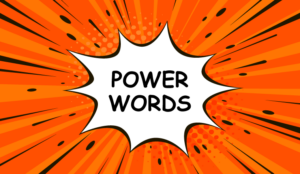You’d be forgiven for thinking body language simply doesn’t matter when you’re having a telephone conversation, but the truth is that it does make a difference.
To find out more, our Editor, Megan Jones, asked the experts why body language really is so important – even when customers can’t see you – and how to encourage agents to pay more attention to this in the contact centre.
Why is Body Language So Important When Talking on the Phone?
Only 7% of a Message is Transferred by the Actual Words Used

and understood by the actual words used
Even when someone is speaking on the telephone, their body language will still reflect their mood and feelings (and this mostly happens unconsciously).
People are surprised when they are introduced to the statistics which indicate that only 7% of the message is transferred and understood by the actual words used, 38% is transferred in the way the words are spoken, and a massive 55% by body language.
Incidentally, these statistics refer to a conversation that is face to face. Logic tells us therefore that if the conversation is over the telephone, the body cannot be seen, which means that a massive 55% of the method for transferring the message is lost.
To that end, one could argue therefore that body language does not even come into the equation when talking on the telephone.
You Really Can Hear Someone Smiling
That isn’t the case though – the body also has a massive effect on our breathing pattern which in turn has a massive effect on the way the words are spoken, as Christine Knott, Managing Director of Beyond The Box Ltd explains:
“We have all heard the comment – you can hear someone smiling and it is true. The muscles in our face are numerous – we have more muscles from our shoulders up than from our shoulders down!
Movement of muscles will affect the sound of the voice. If we smile our voice is lighter, higher and indicates happiness. If we show anger on our faces, the muscles affect our voice too, it will be deeper and more stressed.
Facial expressions affect our voice and our voice transfers key parts of a message to help the receiver understand what is being communicated.
Whether the conversation takes place on the telephone or face to face, the facial expression (which is part of body language) plays a major role in the communication process.”
How to Encourage Agents to Use Positive Body Language Whilst on the Phone
So, how do you bring your team along on this journey and encourage your agents to use positive body language in their day-to-day calls?
Here are some top tips and suggestions to try out:
1. Imagine the Customer Can See You
Tone of voice really sets the scene for the conversation, creating that much-needed emotional connection with customers, as it conveys that they are really listening and care about what the customer is saying. It can even reflect that a situation is serious or help to lighten the mood.
But, if an agent is leaning back in their chair, or slouching with their arms crossed, this could all get lost and change how their voice sounds.
Equally, if they are sat up in their chair and alert – that all goes into the body language and all comes across well in their tone of voice too!
A good way to keep on top of this is to encourage agents to always imagine that the customer can see them – and to speak naturally as if they were having a face-to-face conversation with their friends and family.
If you want advice on improving your tone of voice, read our article: How to Utilize Tone of Voice in the Contact Centre
2. Avoid Looking Down (and Sounding Distracted)
Another good tip is to train agents to avoid looking down during a conversation, as Kim Ellis, Chief Learning Architect at Go Ginger Learning Solutions explains:
“If an agent is looking down (making notes, for example), the customer will hear that in their voice. Try it! You’ll hear your voice getting lower if you bow your head whilst talking.
If this becomes habit, it can make agent consistently sound as though they are distracted and not fully engaged with the customer.
By contrast, looking at the caller screen, as if you they were face to face in the same room, can bring out a difference in tone of voice.”
3. Make Sure Your Agents Have a Comfy Chair
Positive body language and customer conversations also come down to equipment and making sure agents have a chair and office set-up that has a positive impact on their posture and how comfortable they are.

set-up that has a positive impact on their posture
For example, if a remote worker is sat at their dining room table with a wooden chair, the chances are they are going to be shuffling and a bit uncomfortable… and that’s also going to come across in their tone of voice!
It might even subconsciously talk quicker and wrap up calls faster.
So, what do you do about it? Dependent on the contact centre (and its budget), you could give your team members new equipment (including an ergonomic chair, which could help them with their posture).
Or perhaps talk to HR about issuing a fund to buy better home office equipment – for remote and hybrid workers.
Note, all of this should be seen as an investment in CX, as it will make a difference to overall call quality and customer experience.
4. Create an Awareness Campaign to Keep Body Language Front of Mind
In a traditional office-based call centre, part of the role of the floorwalker would be to go around and make sure their colleagues are sitting well – that their body language looks alright – and to nip any bad habits in the bud. For example, like people leaning back in their chairs with their feet on the table.
Of course, this can’t be a full-time job (and is also near-impossible with homeworking agents), so it can really help to create an ongoing awareness campaign for how your body language can affect your customer interactions.
5. Listen Out for Poor Body Language in Your Call Quality Monitoring
You can also try listening out for poor body language during call quality monitoring.
Then, if someone doesn’t sound their best and you suspect they may have been slouching or looking down too much (for example), you can ask “where were you and how were you sitting when making this call, because it sounds like you were not in the best position?”.
Bringing this question into your standard QA process will help to keep the importance of body language front of mind for everyone, but it will also help team leaders to become more comfortable about having these conversations too!
It’s worth reviewing your QA programme regularly, for advice on optimising your QA Strategy, read our article: Call Centre Quality Assurance: How to Create an Excellent QA Programme
6. Show Agents How Their Breathing is Shaped by Their Posture
Breathing patterns play a major role in how words are spoken. As the air from our lungs is exhaled, it passes over the vocal chords, which vibrate to make a sound.
This sound affects the way we say words. Breathe either quickly or slowly and it has a major effect on the vibration. Breath in a shallow manner and that too has an effect on the vibration.
For the exhaled air to pass over the vocal chords, the passageway has to be clear. Crunch your body and the passageway starts to become restricted. Restriction starts to happen when we sit down. This is because our normal reaction is to lower our head and shoulders.
Why not try this simple exercise with your agents to demonstrate this:
- Stand up so the air passage is open and say ‘good morning’.
- Sit down and relax into your chair so that your shoulders and chin are relaxed and say ‘good morning’. Can you hear the difference?
- Remain seated, but sit up in your chair, look ahead and repeat ‘good morning’ again. Can you hear the difference this time?
Customers Can Be Confused by the Wrong Tone of Voice
Did you know… The correct meaning of a conversation can be lost in the wrong tone of voice, as Christine Knott, Managing Director of Beyond The Box Ltd shares:
“I once heard about someone who received a call from the hospital where their mother had been admitted after a stroke.
Someone from the hospital made a telephone call to the daughter. The caller spoke with a very slow pace and the pitch of their voice was very low and the tone very deep.
This slow, deep tone of the voice meant that the patient’s daughter thought she was hearing bad news. She didn’t hear the words that were spoken, just the way they were said.
The caller was in fact notifying the daughter that her mother had been transferred to another ward. If the words had been spoken with a faster pace and a higher pitch, she would have concluded it was a regular call with some general information – no cause to worry.
This is a classic example of how the tone, pitch and pace of the voice are affected by body language, which as a result causes an incorrect interpretation of the words spoken.”
7. Train on Body Language During the Onboarding Period
Body language training shouldn’t be an afterthought, so make sure it’s included as a core part of your onboarding – as well as included it in any ongoing call centre training and refreshers.

Here are some example training exercises to include, as shared by Kim Ellis, Chief Learning Architect at Go Ginger Learning Solutions:
Training Exercise #1 – The Celebrities Game
A good game to play here is to think about different celebrities, and ask agents how they would feel if [insert celebrity name] were dealing with their call?
This should open a lively discussion about the difference in the customer experience would be between Morgan Freeman and Karen from Will and Grace (for example) – particularly the impact of dealing with a complaint or bereavement.
Training Exercise #2 – The Body Language Card
Another idea – if you have an in-person training event – is give people a card as soon as they come into the room that says “slouch and frown all day”, “speak in a deep, monotone voice all day”, or “smile and sit up straight all day” and so on.
Then, at the end of the day, have a conversation about what people thought of that person, and what their impression of them was, to emphasise how body language and tone of voice impact people’s perceptions. You could even play body language charades!
This article was originally written by Christine Knott, Managing Director of Beyond The Box Ltd, and has since been updated with additional insights from Kim Ellis, Chief Learning Architect at Go Ginger Learning Solutions.
If you are looking for more great advice on how to improve your customer interactions, and develop your staff, read these articles next:
- 5 Soft Skills Every Agent Needs Before Taking Their First Call
- Customer Service Skills: How to Improve Empathy, Active Listening and Knowledge
- How to Turn a Bad Agent Into a Good Agent
Author: Megan Jones
Reviewed by: Jo Robinson
Published On: 8th May 2024 - Last modified: 19th Sep 2025
Read more about - Call Centre Management, Christine Knott, Empathy, Kim Ellis, Language, Management Strategies, Positive Words, Top Story


















I think body language in call center still needed due to that is impact to our voice when make conversation with customer..nice article
Very interesting article. I have always thought that many people just assume call-centre work is about your voice, and nothing else matters. When someone speaks to me in a bored monotone I can visualise them slumped in their chair, or staring blankly out of the window…they probably are!
your articles are an exellent source for me as I am studying citp cipp and bus management and looking at an offer of part time training of call centre staff
thank you
regards
Julie Garnett
The company I work for have voice awareness classes and these can have a dramatic effect on how someone is percieved by a customer.
Very good article and so true.
I enjoy your artical which is full of evident features which can happen for any body. Your relevant arguments are significant for those working in telemarketing. Thnx Zizoo
I absolutely agree with everything you said, and you may be alread yaware of thi sbut making a stronger impact with the increased figures, but I believe the 55%BL, 38% Tone, 7%Words split is based on Face-to-Face communciation, whereas over the phone these factors switch to 7%BL 55%Tone 38%Words.
However Body Language is still HUGELY undervalued in Telemarketing, and everything you say here should be paid very close attention to!
The Mehrabian, 7%/38%/55%, misquoted.
Here is a more precise (and necessarily detailed) representation of Mehrabian’s findings than is typically cited or applied:
7% of message pertaining to feelings and attitudes is in the words that are spoken.
38% of message pertaining to feelings and attitudes is paralinguistic (the way that the words are said).
55% of message pertaining to feelings and attitudes is in facial expression.
Also of note, The research was only carried out on women.
I understand this wasnt the purpose of the article, but just added this for additional information.
I found it really useful information for my training sessions. Very straightforward. Well done.